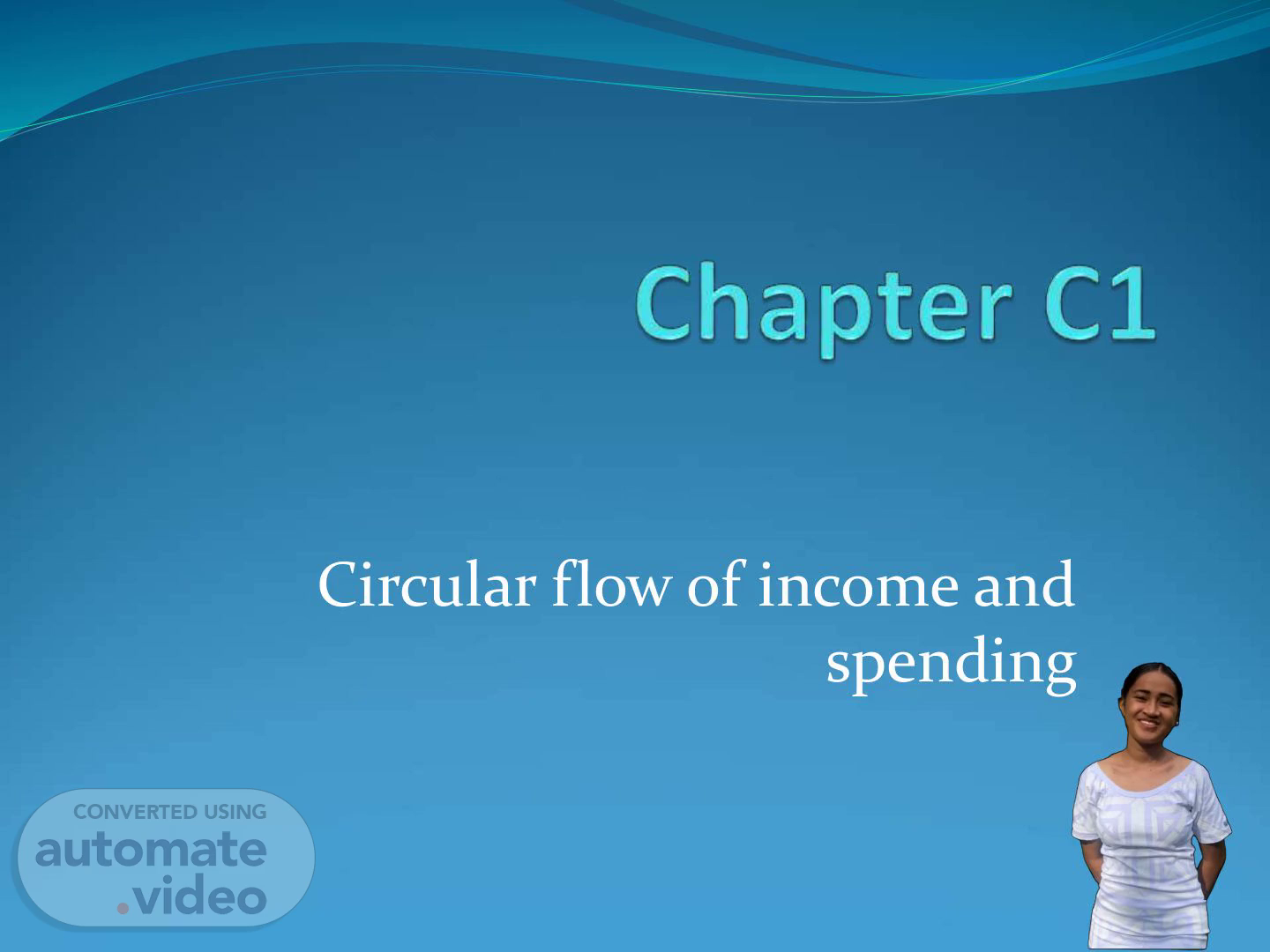Scene 1 (0s)
Circular flow of income and spending. Circular flow of income and spending.
Scene 2 (6s)
Learning Outcomes: By the end of this chapter, you should be able to describe the aggregate level of economic activity, and to demonstrate an understanding of: the aggregate level of economic activities through the Circular Flow model of income and spending from simple to the full sector model. Describe the Components of Aggregate Demand in the system of National Accounts Nominal G-D-P vs Real G-D-P G-D-P Measures: Income and Production Approaches The business or Trade Cycle.
Scene 3 (40s)
Circular Flow of Income & Spending. Circular Flow of Income & Spending.
Scene 4 (46s)
[Audio] Circular flow diagram Circular flow diagram is an economic model which use to illustrate how economics works and how its relates to reality. 2 sector model – involves household and firms. Household – “an economic unit made up of one or more individual living together and engaging in economic activity” or “ a group of consumers living under one roof” (eating together). Firm – “an institution or economic unit, large or small, that uses the factors of production to produce goods and services and engage in profit seeking activity.” or they are producers such as sole trader, partnerships and registered companies.”.
Scene 5 (1m 34s)
[Audio] How the model works? ➢money flow – outer loop (consumption expenditure (C) from household to firms and paying income (Y) from firms to households) ➢real flow – inside loop (household provide resources to firms and firms use them to produce goods and services).
Scene 6 (1m 55s)
[Audio] Money is a STOCK ➢ means of exchange ➢ stock of money(money supply MS) National income is a F-L-O-W. If MS available is $1 meters and circulates within the economy 5 times, then national income would be $5m=(MV=5 tons x M) If all goods produce are consumption goods (national output) and all income spent on consumption good (national income) then: National Output = National Income.
Scene 7 (2m 32s)
[Audio] More complex model (ref to fig C1.2, pg 257) Output consists of spending on goods and services for C Income (Y) includes wages, profits, dividends, interest, rents, and royalties. Savings (S) – “money is put aside for future use, or sacrificing present consumption” Y = C plus S therefore S = Y – C Investment (I) – “an increase in capital formation expanding the productive capacity of the economy.” If S & I low – level of national income and output decrease. If S & I high – level of national income and output will increase..
Scene 8 (3m 22s)
[Audio] Injections (J) and Withdrawals (W) Injections (J) – money flow into the circular flow and there is an increase in the level of economic activity, I , G , 10 Withdrawals (W) – money flows out of the circular flow that decrease the level of economic activity, S, T, M Unplanned saving – If S > I then decrease money flow in circular flow, which lead to unplanned build up stock. Investment spending – also known capital formation may include spending by firms on new plant and machinery or add inventory (stock for later sale). It also means borrow from financial institution and injects in the circular flow..
Scene 9 (4m 12s)
[Audio] Factors affecting investment Interest rate (r) – if r decreases, I increases and vice versa. (cost of investment) If firms feel high confident of what they invest in will produce high sales or profit in the future– Investment will increase (business confidence) Replacing worn out or depreciated capital – increase Investment. If I > S = economy will grow or increase..
Scene 10 (4m 43s)
[Audio] Unplanned investment When there is pile up stock (positive unplanned investment) ready for sale i.e inventories. Negative unplanned investment is rundown of stocks. Changes in stock (ΔR) So national output (Y) = C plus I plus ΔR So national income (Y) = C plus S.
Scene 11 (5m 11s)
[Audio] So national income (Y)= national output (Y) C plus S = C plus I plus ΔR (cancel C on both sides) S = I plus ΔR Changes in national income National income will change as a result of change in ΔR (changes in stock) Investment spending is exogenous meaning it is independent of changes of income. Savings is induced meaning it is dependent on level of income (as income increases S increases.).
Scene 12 (5m 45s)
[Audio] With reference to Table C1.1 pp277 Reader.. If expenditure is greater than national income, ΔR is negative. Firm will respond by increasing production lead to increase in income, S increases to match investment. If output were high there will be unplanned investment or build up stock. Equilibrium where S = I no value in ΔR. If I >S, ΔY increases. If I < S, ΔY decreases. If I = S, ΔY is zero..
Scene 13 (6m 12s)
[Audio] Equilibrium Income Fig C1.6 pp282. Equilibrium Income Fig C1.6 pp282.
Scene 14 (6m 19s)
[Audio] Equilibrium level of national income (Ye) when J = W Refer to fig C1.6 …..for an open ECONOMY At Ye = equilibrium (S=I) At Y1 = I > S, demand for goods and services increases, employment increase, stock is running down, national output and income increases. (Economic activity increases). So income level will increase towards equilibrium (Ye)..
Scene 15 (6m 49s)
[Audio] At Y2 = I < S, demand for goods and services decreases, employment decrease, stock is bile up, national output and income falls. (Economic activity decrease). So income level will decrease towards equilibrium (Ye). 3 sector model consists of households (H), firms (F) & government. (Fig C1.3, pg 279) Govt collects taxes (T) from H & F and use them to provide or produce collective goods and services, known as government expenditure or spending (G).
